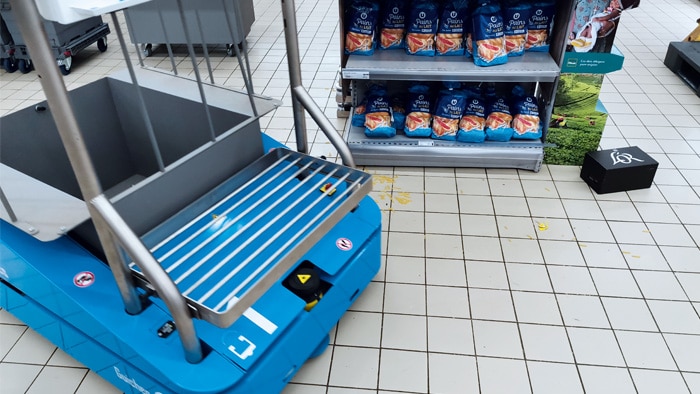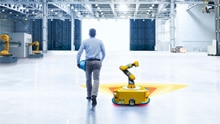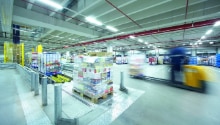Following in the footsteps of Google, Pierre Legendre and Benjamin Loize caught the start-up bug in 2015 and focused their energies fully on innovation: Both worked as engineers at U GIE-IRIS in France on a solution to facilitate manual work in the drive-in branches of Système U supermarkets. This new way of shopping is becoming increasingly significant. However, it also increases the risk of back problems or exhaustion among staff due to the high physical strain of putting together the purchases. At the same time, cost-effectiveness plays an important role. Organization and productivity are the big challenges. For example, products are placed on the shelves by employees, but then removed by others for drive-in pickup.
Mobile robot revolutionizes work in supermarkets
The birth of SUitee Cobotics
Pierre Legendre and Benjamin Loize worked for two years on a project to aimed to reduce workload and increase the profitability of drive-in service. They suggested to company management that employees in the stores be provided with a life-size robot to assist them with particularly strenuous tasks, such as transporting heavy products to restock shelves or frequently moving merchandise between the warehouse and the sales area. Système U gave them free rein in implementing this autonomous assistance robot. In cooperation with other industry partners, they developed a mobile robot that was tested in various markets.
The two engineers presented their project to the shareholders and owners of Système U’. Their ideas were met with interest, but since the manufacture of mobile robots does not exactly fall within the core business of U GIE-IRIS, the innovative program was discontinued. So they were faced with a choice: Return to their earlier projects, or leave the company to create the mobile robots themselves?
Setting out on a new adventure with SICK
In March 2018, they decided to found their own start-up. Six months later, SUitee Cobotics sees the light of day. An agreement is made with Système U that Legendre and Loize will be allowed to use all the results of their previous project, enabling them to simply pick up where they left off. However, they soon discover that not everything is as ready as they thought – and they start all over again.
For two years, they rework the entire concept, from design and form to technology.
The mobile robot must be able to work in two modes: On the one hand, it must move autonomously (independent motion between the warehouse and the sales area), and on the other hand, it must assist staff in restocking goods (motion with a person). Since the robot will be moving in confined areas, often along many customers, a very high level of safety must be achieved to avoid collisions and accidents.
The founders of SUitee turned to SICK in France to figure out how to best to meet the safety requirements of a mobile robot. “SICK is one of the few manufacturers in the world that makes products with the high safety standards we are aiming for with our robot,” says Pierre Legendre. “There are many manufacturers of LiDAR sensors, but when it comes to complying with mandatory safety standards, the herd is quickly thinned out,” adds Benjamin Loize.
That’s why SUitee Cobotics contacted Yannick Planchenault, the responsible sales engineer at SICK, to find the right LiDAR sensors for the planned prototype. Once on site, they selected the appropriate sensor solution together with the expert for mobile applications, Jeffrey Yannou. A product training course was then held at the SICK agency in Nantes.
First-class equipment for the safety of us all
The mobile robot had to be introduced in the stores without any structural changes. That means marking lines on the ground as well as GPS antennas or transmission towers were out of the question. Instead, the robot had to be equipped with extremely precise sensor technology, because ultimately it should be equally capable of reaching a precisely defined goal on its own and of safely following a person.
The SUitee mobile assistance robot features various 2D LiDAR sensors and safety laser scanners. These include three for safety (S300 and TiM-S safety laser scanners), a 3D infrared camera, on-board AI, a safety controller (Flexi Soft) as well as incremental encoders with safety functions (DFS60S Pro) and a control developed by SUitee Cobotics.
LiDAR sensors from SICK are used for point-by-point mapping of the building interior. The raw data is then retrieved, which engineers use to generate a map of the supermarket. This map is then stored in the system. The TiM510 2D LiDAR sensor and the TiM-S safety laser scanner, both specially designed for mobile applications, are characterized by high reliability when detecting obstacles or measuring the surroundings.
Thanks to the various sensors, the mobile robot can move from point A to point B on its own. It can set its route, weave between stationary obstacles (lift trucks, boxes), slow down or stop when it encounters people, and even calculate a new route if a path is blocked. It is also capable of following and accompanying a person in the appropriate mode.
Despite delays due to lockdown restrictions, the founders of SUitee Cobotics were able to complete their tests before the summer thanks to the extensive availability of the SICK teams. These produced the desired results and the first autonomous assistance robots have already been delivered.
Read more
The new mobility: How sensors control the cobots of the future
Light at the end of the tunnel - disinfection using UV light and nanoScan3
Reliable measurements no matter how diverse or colorful the products
눈높이 협력
로봇 비전, Safe Robotics, End of Arm Tooling 또는 포지션 피드백 등 어떤 과제도 문제없습니다. SICK 센서는 로봇에 정밀한 인지력을 부여합니다.
더 알아보기











